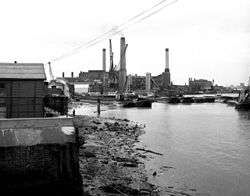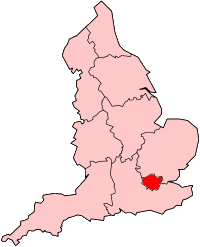Deptford Power Station
| Deptford Power Station | |
|---|---|
 Deptford West Power Station Viewed from the east in July 1973 | |
 Location of Deptford Power Station in Greater London | |
| Country | England |
| Location | Greater London |
| Coordinates | 51°28′57″N 0°01′13″W / 51.4824°N 0.0203°WCoordinates: 51°28′57″N 0°01′13″W / 51.4824°N 0.0203°W |
| Commission date |
1891 (Depford East LP) 1929 (Deptford West) 1853 (Deptford East HP) |
| Decommission date |
Late 1960s (Deptford East LP) Early 1970s (Deptford West) 1983 (Deptford East HP) |
| Operator(s) | London Electric Supply Corporation 1891-1925, London Power Company 1925-48, British Electricity Authority 1948-54, Central Electricity Authority 1954-57, CEGB 1957-83 |
| Thermal power station | |
| Primary fuel | Coal-fired |
| Power generation | |
| Nameplate capacity | 448 MW (70 MW approx Deptford East LP, 212 MW Deptford West, 166 MW Deptford East HP) |
| grid reference TQ374778 | |

Three distinct coal-fired power stations were built at Deptford on the south bank of the Thames, the first of which is regarded as the first central high-voltage power station in the world.[1]
History
Deptford East LP
(LP = Low Pressure). One of the first premises in London to be supplied with electricity was the Grosvenor Gallery in Bond Street. It was the brainchild of the Earl of Crawford, who had been inspired in 1881 by the International Exposition of Electricity in Paris. A power plant was duly built at the Grosvenor Gallery. It was designed to supply just lighting for the gallery but it was soon extended to supply nearby shops and residences and a larger power plant was opened in 1884. With the prospect of expanding still further, the London Electric Supply Corporation was formed (LESCo). Principal shareholders were the Earl of Crawford, his friend Sir Coutts Lindsay and Sir Coutts’ brother, Lord Wantage.
There were environmental objections to large-scale power generation in Central London, so LESCo decided to move to a new site in Deptford and to use the Grosvenor Gallery site as a substation. A feature of the Grosvenor scheme was its use of alternating current (AC) in preference to direct current (DC). The use of AC allowed the voltage to be raised to 10 kV for transmission between Deptford and Grosvenor Gallery. High-voltage cables were laid alongside the London & Greenwich railway line, but cable design at that time was rudimentary, having short lengths and many joints. This caused a voltage drop of some 10% from end to end. In order to supply at 10 kV at Grosvenor Gallery substation, the design voltage at Deptford had to be set at 11 kV, which is why national transmission voltages became standardised in multiples of eleven.
Sebastian de Ferranti was appointed to engineer the scheme, and the world’s first central power station opened at Deptford in 1889. ‘Central’ means that it was remote from most of its consumers. To distinguish it from later adjacent developments, Farranti’s power station subsequently took the name Deptford East LP. It was pioneering not just because it was ‘central’ but because of its unprecedented scale and high voltage. It was built on a 3-acre warehouse site called The Stowage which once belonged to the East India Company. There were initially two generators driven by reciprocating steam engines, supplied by 24 boilers burning coal brought by collier from Newcastle. There were teething problems both at the power station and at the Grosvenor Gallery substation, resulting in lengthy shutdowns and loss of customers. Ferranti himself was sacked in 1891 and was succeeded by G.W. Partridge as chief engineer. The plant was rebuilt with steam turbines and other improvements, and electricity supply eventually became reliable. Demand increased steadily with consumers supplied through different systems as follows:
Domestic and commercial consumers at 83.33-cycle single-phase AC.
Industrial and other consumers with three-wire DC and a choice of two voltages.
Trams, railways and other consumers at 25-cycle single-phase AC.
When Britain eventually standardised to 50-cycle three-phase AC, Deptford East LP was downsized to just a few 25-cycle turbine-generators. To feed the 50-cycle National Grid from the LP station, a frequency converter was installed in Deptford West. This motor-generator was commonly known as The Freak. Deptford East LP closed in the late 1960s.
Deptford West
In 1925, ten electricity supply companies, LESCo among them, amalgamated to become the London Power Company. Deptford West was conceived by LESCo but was built by LPC and was engineered by Leonard Pearce. The turbine house basement was built in a former dry dock. Initially, the station had two turbine-generators, a bank of coal-fired boilers and a single large concrete chimney at the northern end. Four additional turbine-generations were added in the late 1930s together with three house sets, additional boilers and a second chimney. Staff claimed that the basement of No. 2 turbine-generator was haunted by the ghosts of those who had died on the gibbets alongside the dry dock. This may have been on the site one of the original dry docks founded by Henry VIII for the Royal Navy. Deptford West closed in the early 1970s.
Deptford East HP
(HP = High Pressure). When the electricity industry was nationalised in 1948, power generation came under the auspices of the British Electricity Authority. Deptford East HP opened in 1953 with three turbine-generators, a range of coal-fired boilers and a single chimney. The original plan had been to demolish the LP station to make way for an extension of the HP station, doubling its size. This was never realised because the rapid rate of rise of electricity demand needed much larger power plants than could be accommodated at Deptford. The HP station closed in 1983 under the auspices of the CEGB.
Deptford site as a whole
The Deptford site was targeted in both World Wars. In 1916, a Zeppelin dropped a 250 lb bomb, killing one man and putting the entire traction and industrial switchboard out of action, but lighting supplies were restored within 12 minutes, and traction supplies were restored within 24 hours. During the Second World War, 27 Deptford staff were killed by bombs. The most extensive damage was caused by a bomb on the West switch house. The site as a whole was redeveloped during the 1990s with luxury apartments and a slipway for dinghies. The coaling jetty in the Thames survives. Also surviving are some walls of the west boiler house, which have been incorporated into the apartment structure. A nearby park was developed from a derelict site and was named Ferranti Park as a tribute to one of the great industrial pioneers. Finally, here is a summary of all the turbine-generator ratings in the mid 1960s:
Deptford East LP 70 MW approx from several turbine-generators
Deptford West 212 MW (2 x 25 + 3 x 35 + 1 x 50 + 7 MW from three house sets)
Deptford East HP 166 MW (3 x 55.5)
Deptford Site Total 448 MW
This compares with 4,000 MW at Drax and 3,200 MW at Hinckley Point C. Although Deptford was small by modern standards, its contribution to the war effort and to the post-war recovery period was invaluable.
Coal supply
Coal was brought by sea from North East England or South Wales. The LPC and its nationalised successors had its own fleet of coastal colliers for this service, such as the 2,268 GRT SS Francis Fladgate built in 1933 and 2,904 GRT SS Oliver Bury built in 1945.[1]
References
- ↑ Anderson, James B (2008). Sommerville, Iain, ed. "Ships built by the Burntisland Shipbuilding Company Ltd: arranged by date of launch". Welcome to Burntisland. Iain Sommerville. Retrieved 15 June 2011.
NB these are additional to those on the existing website. The original list of references has somehow been deleted while trying to add the new ones. I became totally lost by the Help page on References.
Alan Postlethwaite’s personal recollections from working at Deptford West in the 1960s.
Cochrane, Rob, Cradle of Power, the Story of Deptford Power Stations.
Deptford Power Station, 1912. http://carolineld.blogspot.co.uk/p/blog-page.html
Rewrite of the INFOBOX before opening the website (I have notified these changes and await their application):
Opened: 1889
Decommission date: 1983
Architects: Sebastian Ziani de Ferranti (Deptford East LP), Leonard Pearce (Deptford West)
Operators: London Electric Supply Corporation, London Power Company, British Electricity Authority, Central Electricity Authority, Central Electricity Generating Board
External links
| Wikimedia Commons has media related to Deptford Power Station. |
- 'Ferranti’s Deptford Power Station' - South Western Electricity History Society
- Deptford East 1882 alternator
| Preceded by Forth Banks Power Station |
Largest Power Station in the UK 1891-1901 |
Succeeded by Neptune Bank Power Station |

